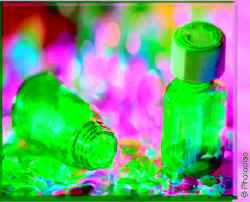MDMA (3,4-methylenedioxymethamphetamine, also known as ecstasy) is a
synthetic (man-made) drug that causes both hallucinogenic and
stimulant effects. The drug was developed in Germany in the early
twentieth century as an appetite suppressant, but today's users
consume the drug for its hallucinogenic effects, which they claim
heighten their senses and make them feel less inhibited. Users also
consume MDMA for its stimulant properties, which enable them to dance
for hours at all-night parties and nightclubs.
MDMA generally is sold as a tablet, which is taken orally. MDMA
tablets are available in various colors and shapes and generally are
imprinted with a logo. Popular logos include smiley faces, clover
leaves, cartoon characters, and symbols associated with commercial
brands such as Mitsubishi, Nike, and Mercedes.
Most MDMA users are teenagers or young adults. More than 10 percent
of high school seniors have tried MDMA at least once, and more than 2
percent have used the drug in the past month, according to the
University
of
Michigan's Monitoring the Future Survey. MDMA users
typically come from middle- and upper-class households. MDMA is
inexpensive. The average retail price of an MDMA tablet is between $20
and $30 making it attractive and accessible to younger users.
To Top
Where is it used?
MDMA is called a club drug because it often is used at all-night
dance parties (called raves) or at techno parties and nightclubs. In
addition, MDMA increasingly is being used in private homes and on high
school and college campuses.
What are the risks?
The effects produced by consuming MDMA can last for 4 to 6 hours,
depending upon the potency of the tablet. Using the drug can cause
confusion, depression, anxiety, sleeplessness, craving for the drug,
and paranoia. Use of the drug also may result in muscle tension,
involuntary teeth clenching, nausea, blurred vision, tremors, rapid
eye movement, sweating, or chills. People who have circulatory
problems or heart disease face particular risks because MDMA can
increase heart rate and blood pressure.
MDMA abusers also risk dehydration, hyperthermia (exceptionally
high fever), and heart or kidney failure if they use the drug while
physically exerting themselves or in hot environments. (These factors
pose particular risks to individuals who use MDMA at raves or techno
parties, where they may be dancing among crowds of people.)
Users also are at risk of consuming other drugs that may be sold to
them as MDMA. In some instances, the synthetic drug PMA (paramethoxyamphetamine) has
been sold as MDMA. Because PMA's hallucinogenic
effects take longer to appear, users may consume too much of the drug,
which can result in overdose death.
An additional risk results when other substances are added to MDMA
tablets without the user's knowledge. Drugs such as heroin and
methamphetamine reportedly have been added to MDMA tablets in some
parts of the United States.
To Top
The most common names for MDMA are ecstasy, Adam, and XTC. (Please
see the below for additional names.)
Street Terms for MDMA
|
B-bombs
Clarity
Cristal
Decadence
Disco biscuit
|
E
Essence
Eve
Go
Hug drug
|
Iboga
Love drug
Morning shot
Pollutants
Scooby snacks |
Speed for
lovers
Sweeties
Wheels
X |
|
Yes, MDMA is illegal. Since 1985 MDMA has been a Schedule I
substance under the Controlled Substances Act. Schedule I substances,
which include heroin and LSD, have a high potential for abuse and
serve no legitimate medical purpose.
To Top
Other products of interest:
Check out Fast Facts on:
- Crack cocaine
- Crystal methamphetamine
- GHB
- Heroin
- Inhalants
- Jimsonweed
- Ketamine
|
- Khat
- LSD
- Marijuana
- Methamphetamine
- PCP
- Powdered cocaine
- Prescription drugs
- Yaba
|
|
Also available from NDIC:
- Huffing--The Abuse of Inhalants
- Prescription Drug Abuse and Youth
- Drugs, Youth, and the Internet
For more information on illicit drugs check out our web site at:
www.usdoj.gov/ndic. Call 814-532-4541 to request NDIC products.
Our addresses:
National Drug Intelligence Center
319 Washington Street, 5th Floor
Johnstown , PA 15901-1622
Telephone: 814-532-4601
FAX: 814-532-4690
NDIC Washington Liaison Office
8201 Greensboro Drive, Suite 1001
McLean , VA 22102-3840
Telephone: 703-556-8970
FAX: 703-556-7807
NDIC publications are available on the following web sites:
ADNET http://ndicosa
LEO home.leo.gov/lesig/ndic
RISS ndic.riss.net
INTERNET www.usdoj.gov/ndic
To Top
|


 What does it
What does it